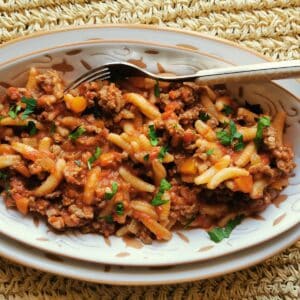Bring the authentic flavors of Sardinia to your home with this malloreddus with lamb ragu. It’s ready in under 90 minutes, giving you a gourmet meal that is easy to make, yet rich and delicious. In fact, this is one of the best lamb ragu recipes I know!
History
Sardinia is an island with a deep-rooted pastoral culture and is home to approximately 4 million sheep, making it a significant producer of Italy’s famed Pecorino Romano cheese. This abundance of sheep also influences the local cuisine, with lamb featuring prominently in many traditional dishes. Among these, you can find this delicious malloreddus with lamb ragu.
Sardinian lamb is one of just over 80 products that have what in Italy is known as IGP certification. This means the origin and quality of the product is guaranteed. Needless to say, Sardinian lamb is a delicious meat. It is delicate, tender, very digestible and rich in lean proteins.
In Sardinia, lamb ragu is often served with a typical local pasta called fregula. This is basically toasted small balls of semolina dough and is quite similar to couscous. However, malloreddus with lamb ragu is another typical lamb pasta recipe. This ragu can also be served with short pasta likeè cavatelli or pasta ribbons such as tagliatelle.

Malloreddus is the Sardinian name for what many call Sardinian gnocchi (gnocchetti Sardi), so called because of their shape. They really look like tiny potato gnocchi but are, in fact, made of durum wheat semolina flour, water and salt.
Ingredients
Malloreddus (Sardinian Gnocchi): These small, ridged pasta shapes are perfect for catching and holding the hearty ragu. If malloreddus is not available, fregola (fregula), cavatelli or tagliatelle can serve as suitable substitutes.
Lamb: For the meat, both bone-in and boneless cuts of shoulder or leg are suitable. If you have bone-in lamb, you can use the bones to make a rich lamb stock for the ragu. Simply remove the meat from the bones and chop it into very small pieces for the sauce.
Tomatoes: You can use either fresh tomatoes or tomato passata, depending on your preference. If fresh tomatoes are being used, immerse them in boiling water for 2 minutes, then rinse and peel them. Cut the peeled tomatoes in half and remove the seeds.
Onions, Carrots and Celery: Finely chopped, they form a classic soffritto that provides a sweet and aromatic base for the ragu.
Garlic Cloves: Adds depth to the ragu; make sure to use fresh garlic over pre-minced garlic.
Bay Leaves: These aromatic leaves add subtle yet complex flavors to the dish.
Pecorino Romano Cheese: Grate fresh for the best flavor. This sharp, salty cheese enhances the finished dish, adding a savory flavor.
Wine: A half glass of red or white wine enriches the ragu, adding acidity and depth. Choose a dry wine to complement the robust flavors of the lamb.
Peperoncino (Red Chili Pepper): Optional for those who enjoy a bit of heat, it adds a subtle spice that can be adjusted according to personal preference.
Beef, Chicken or Vegetable Stock: Two ladles help to create a richer and flavorful sauce, though homemade lamb broth can add an even deeper layer of flavor.

Expert Tips
Homemade Lamb Broth: Add more depth to your lamb ragu by making your own lamb broth. Start by peeling an onion and cutting it in half. Wash and roughly chop the celery and carrot into 2-3 large pieces. Place the lamb bones, prepared vegetables, and a bay leaf in a large pot. Cover with enough water to submerge all the ingredients and bring to a simmer.
Let it cook gently for at least an hour and a half, partially covered. During this time, skim off any fat that rises to the surface. This homemade broth will add a richer and more robust flavor to your lamb ragu.
Cooking with Wine: Adding wine to your ragu will enhance its flavor profile. After browning the lamb, deglaze the pan with a good splash of red or white wine, depending on your preference. Allow the wine to simmer until it reduces by at least half, which burns off the alcohol while concentrating the rich flavors left in the pan.
Pasta Water Tip: When you drain your cooked malloreddus, remember to reserve some of the pasta water. This starchy liquid is an Italian cook’s secret for adjusting the consistency of the ragu. If the sauce thickens too much after adding the pasta, stir in the reserved pasta water a little at a time until you achieve the desired consistency.
Step by Step Instructions
1) In a Dutch oven or large pot, heat the olive oil over medium heat. Add the bay leaves and garlic, sautéing until the garlic softens.
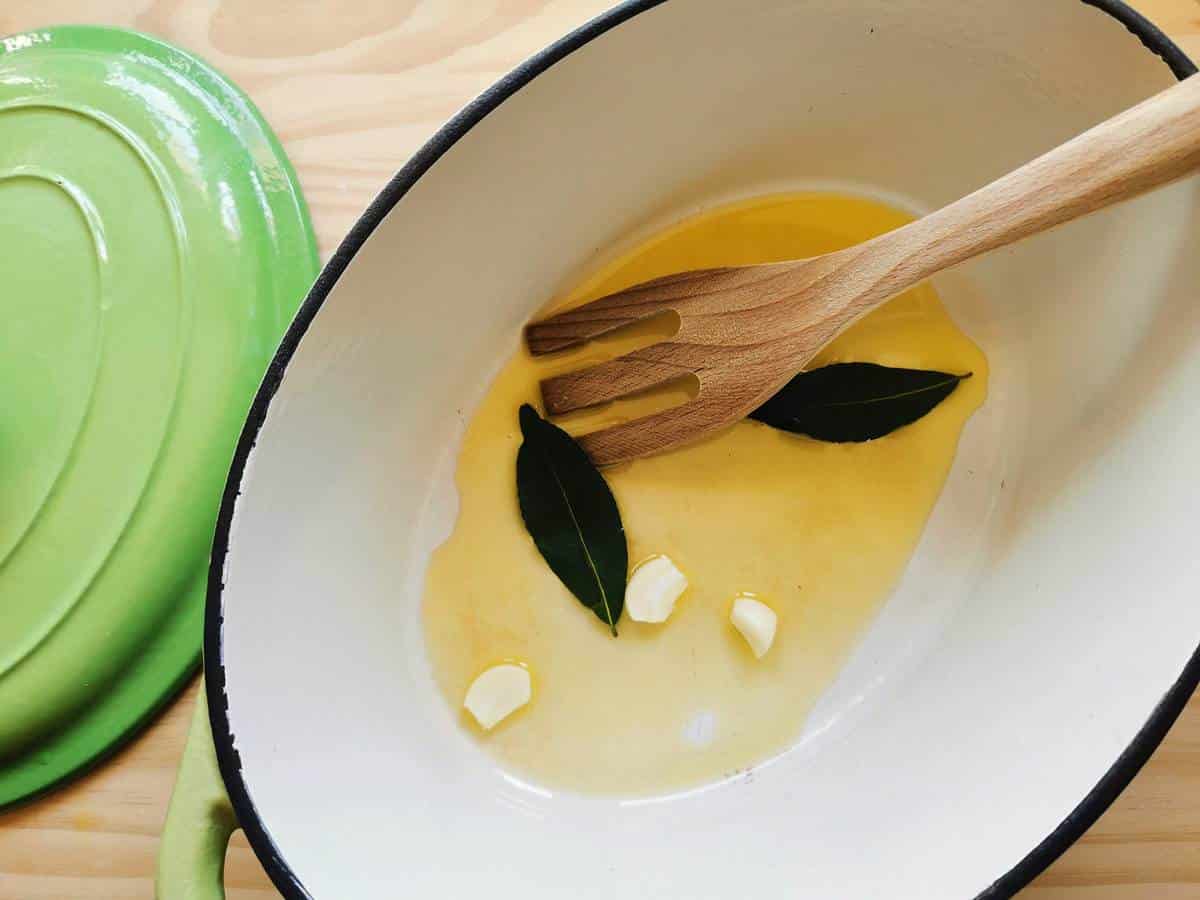
2) Increase the heat to high, add the lamb and peperoncino, and brown for about 5 minutes. Remove the lamb and set aside.

3) In the same pan, reduce to medium heat and add the onion, carrots and celery. Cook until the vegetables have softened, about 10 minutes.

4) Return the lamb to the pan. Pour in the wine and allow the alcohol to evaporate. Season with salt and pepper.
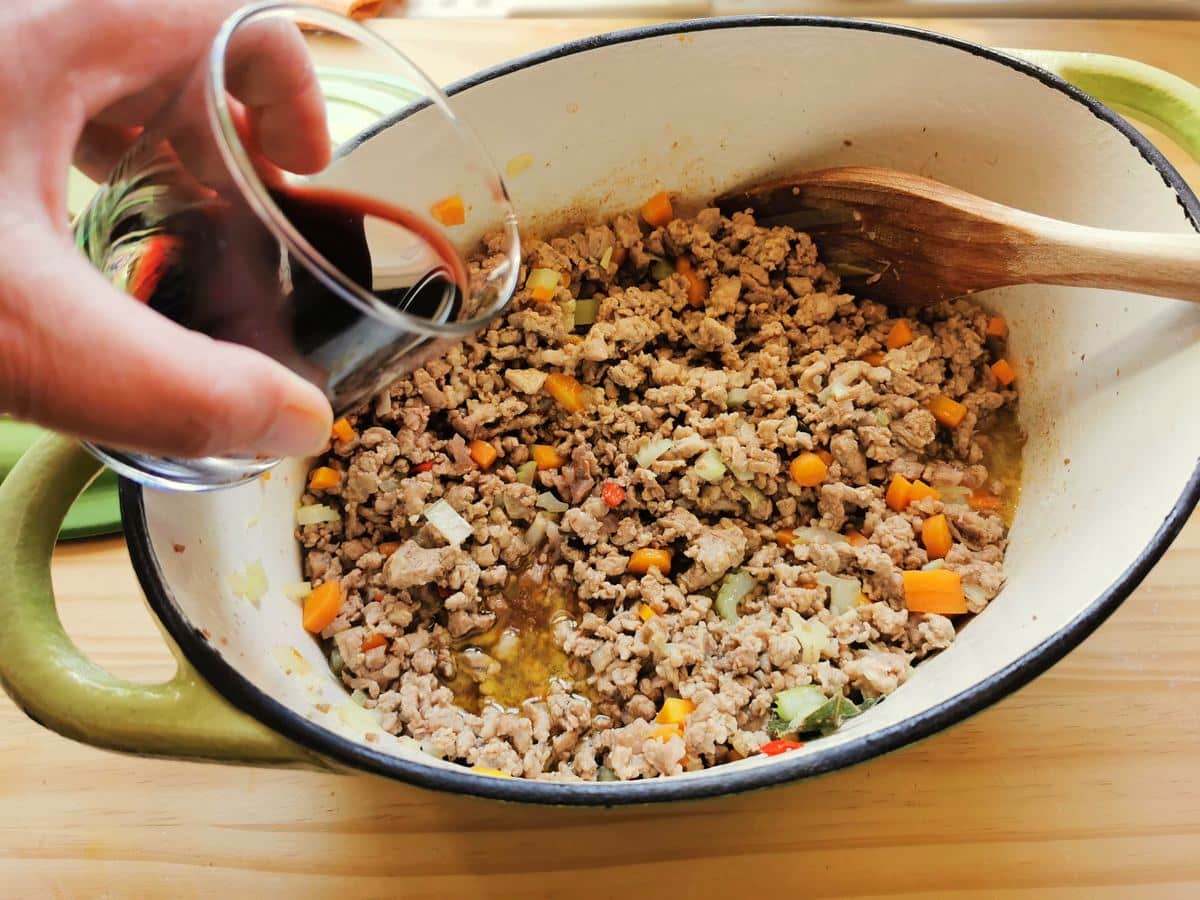
5) Add the tomato passata and broth. Bring to a simmer, cover, and cook on low heat for about 1 hour, or until the lamb is tender. Stir occasionally and add more broth, passata or water if the sauce thickens too much.
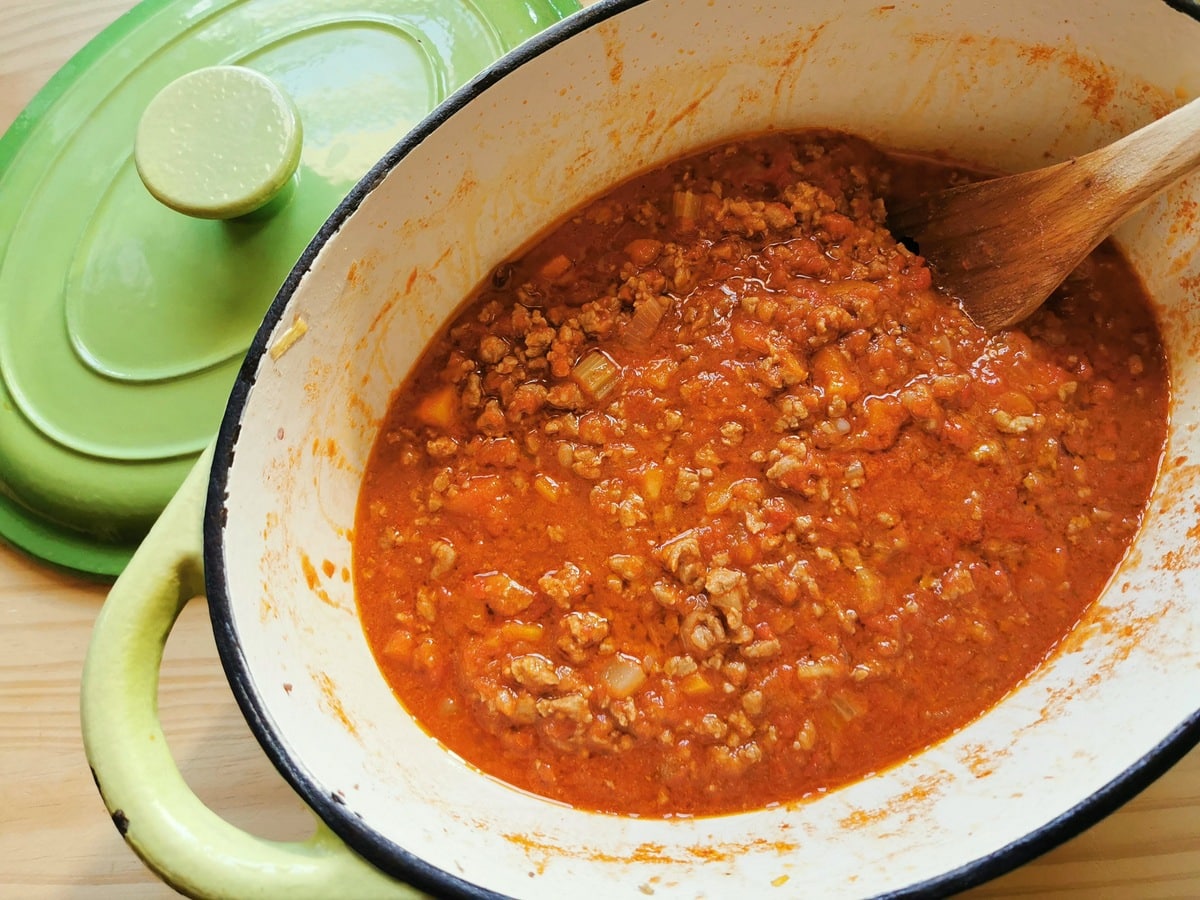
6) In the meantime, bring a large pot of water to a boil add salt and bring to a boil again. Add the malloreddus and cook until al dente, according to package instructions. Drain and reserve one cup of pasta water.
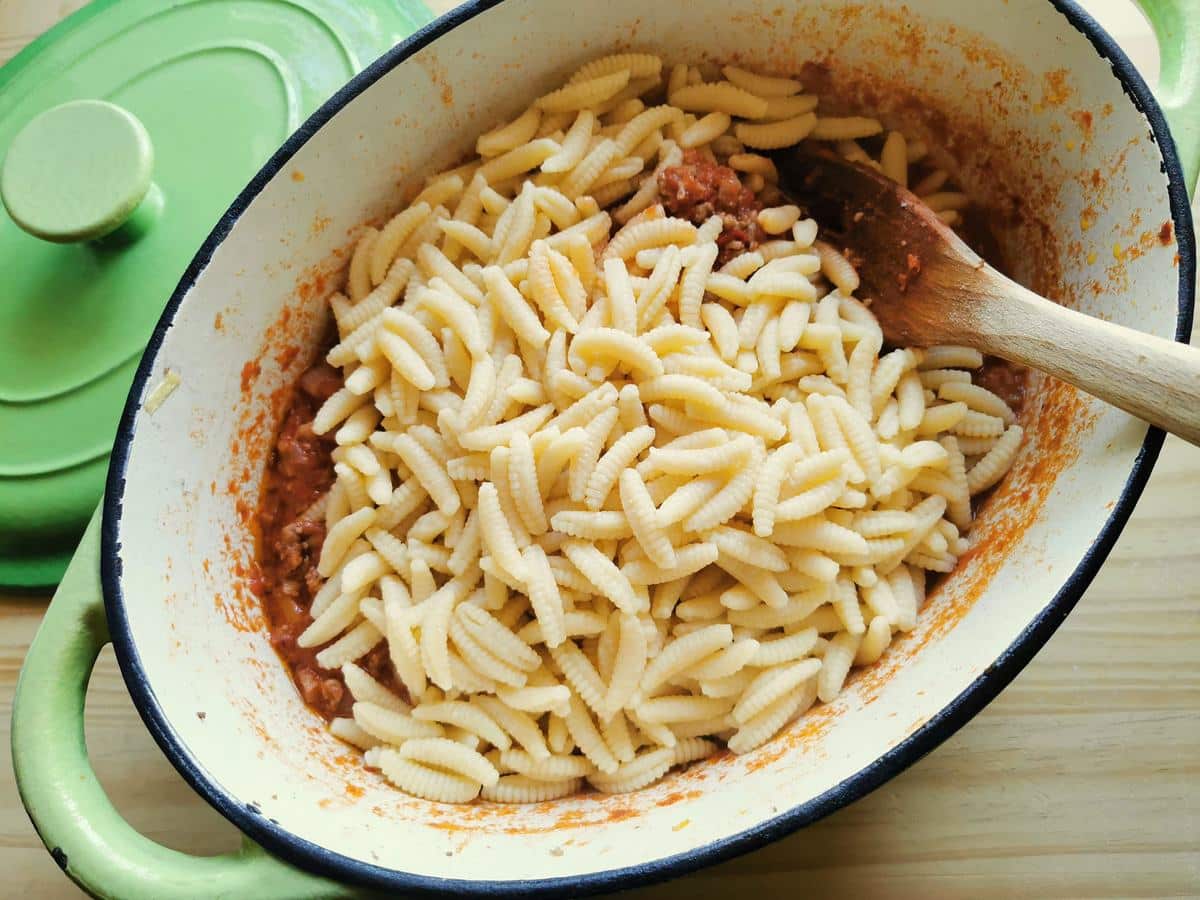
7) Add the cooked malloreddus to the lamb ragu. If the sauce is too thick, adjust the consistency with the reserved pasta water. Sprinkle with grated Pecorino Romano cheese and mix well.
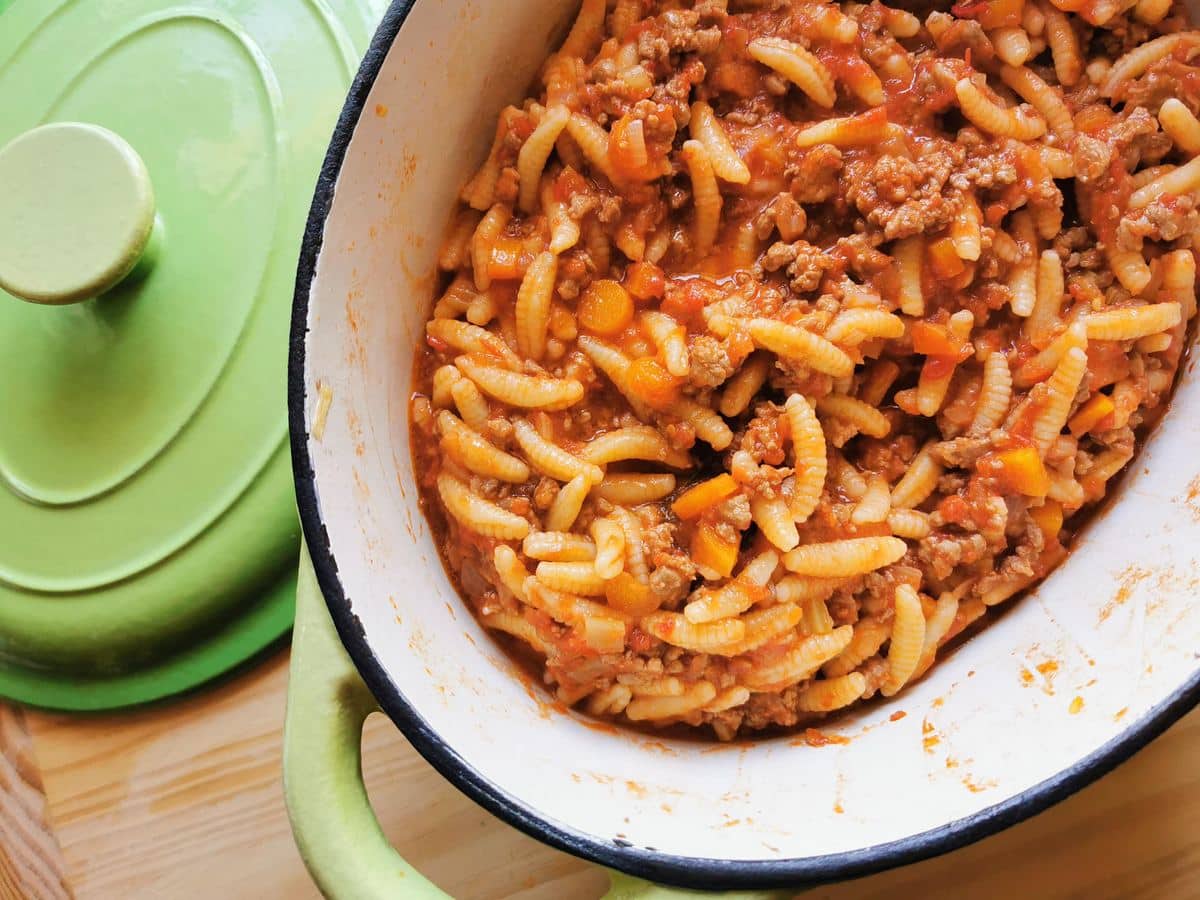
8) Serve hot, with additional Pecorino on the side if desired.

Storage and Leftovers
Allow the malloreddus with lamb ragu to cool to room temperature before transferring it to an airtight container. Place it in the refrigerator, where it will keep fresh for up to 3 days.
To reheat the leftovers, place the pasta and lamb ragu in a microwave-safe container and cover it. Heat on medium power for about 2 minutes, then stir. Continue heating in 30-60 second intervals, stirring in between, until the dish is hot throughout.
You can also bake leftover pasta mixed with lamb ragu in the oven. Sprinkle the top with some grated Pecorino, and bake until the top is slightly crispy ane browned.
FAQs
Yes, you can prepare the lamb ragu a day ahead, as it allows the flavors to meld beautifully overnight. Store it in the refrigerator and reheat gently before serving with freshly cooked pasta. This makes it an ideal dish for entertaining or busy weeknights.
While not strictly necessary, homemade lamb broth adds a rich layer of flavor to the ragu that enhances the overall taste of the dish. If time or resources don’t allow, using a good quality store-bought beef, chicken or vegetable stock is a suitable alternative.
Depending on your location, you might be able to find lamb in a few different places. Lamb is sometimes available in well-stocked large supermarkets or local butcher stores. Alternatively, online specialty stores can be a good way to get premium lamb directly to your door.
More Recipes You May Like:
If you make malloreduss with lamb ragu recipe, I’d love to hear how it turns out and if you liked it. Please leave a comment here on the blog or on The Pasta Project Facebook page. Looking forward to hearing from you.
Buon appetito!
Pin for Later:

If you are interested in learning how to make homemade pasta and different types of gnocchi, check out my shop page for some great video online courses from my friends in Rome! Nothing beats learning to make pasta from Italians! Plus while you’re there why not order a copy of one of my pasta recipe cookbooks or checkout some recommended pasta making tools? All great prezzies for pasta lovers!


